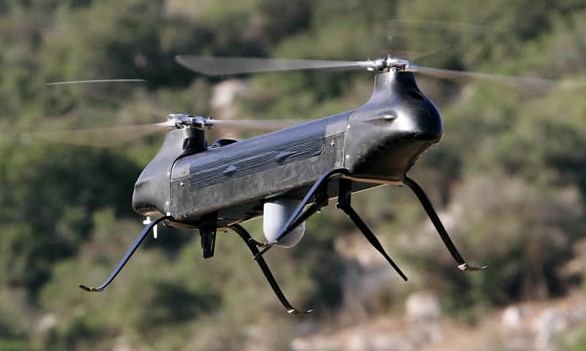
IAI Malat is unveiling the Ghost and Mini Panther, two new vertical take-off and landing miniature unmanned vehicles currently undergoing test flights, both are expected to be ready for marketing soon. Both vehicles will be displayed at the AUVSI exhibition in Washington next week. The Ghost, 145 cm long (4.76 ft) vehicle designed specifically to support special operations units and and company level infantry operations. Ghost was optimized for operation in built-up areas, rugged terrain and dense brushes, typically of the terrain in South Lebanon. As an electrically powered, twin-rotor mini-UAV Ghost is capable of operating on missions of about 30 minutes.

Its aerodynamic configuration and twin-rotor propulsion system contributes to high stability in hovering mode, and effective station keeping even in strong sidewinds and gusts. The twin rotors create adequate lift within a relatively small diameter (0.75 cm / 2.46 ft), enabling the Ghost to navigate safely near obstacles, enter through windows and hover inside built-up areas or penetrate dense vegetation. The twin rotors are powered by two separate, synchronized electrical motors, offering some redundancy in case one motor is disabled. In fact, the Ghost designers expect the final version to be able to recover back to safe ground using a single motor. The Ghost can travel at speed from 35 knots (64 km/h) to zero.
The stealthy Ghost operates quietly in day or night. Its hovering capability provides the user flexible view of the area of interest, including a unique horizontal visibility, unavailable with other flying sensors. The Ghost weighs only four kilograms (9 lb.) and comes packed in a suitcase carried by a single soldier. A system is comprising two vehicles, spare batteries and control station employing a laptop computer. Ghost can carry a payload weighing up to 600 gr (21 oz). The current payload includes the stabilized daylight MicroCam D from Nextvision, An IR night capable sensor is also available at a compatible weight; other payloads are also considered by IAI for future missions.


To support indoor operations the EO system is equipped with mapping capability, automatically measuring indoor space perimeters, to enable the Ghost safe entry and maneuvering inside a room.
Mini Panther is another electrically powered VTOL UAV developed at IAI. Mini Panther weighs 12 kg and is configured for backpack operation by a single infantryman. Its mission endurance can reach 90 minutes, carrying a payload weight of up to one kilogram. While capable of automatically takeoff and landing in vertical mode, Mini Panther performs its mission mostly in forward flight, a mode consuming less power, enabling extended mission endurance.
In 2007 Defense Update reported on an earlier design called ‘DP-6 Whisper‘, developed by Michael W Piasecki, founder of Dragonfly Pictures. The Whisper had similar attributes such as acoustic stealth. The Whisper was also proposed to deploy as a persistent airborne tethered sensor boosting perimeter security around Forward Operating Bases, tethering power from a battery or generator on the ground.
















